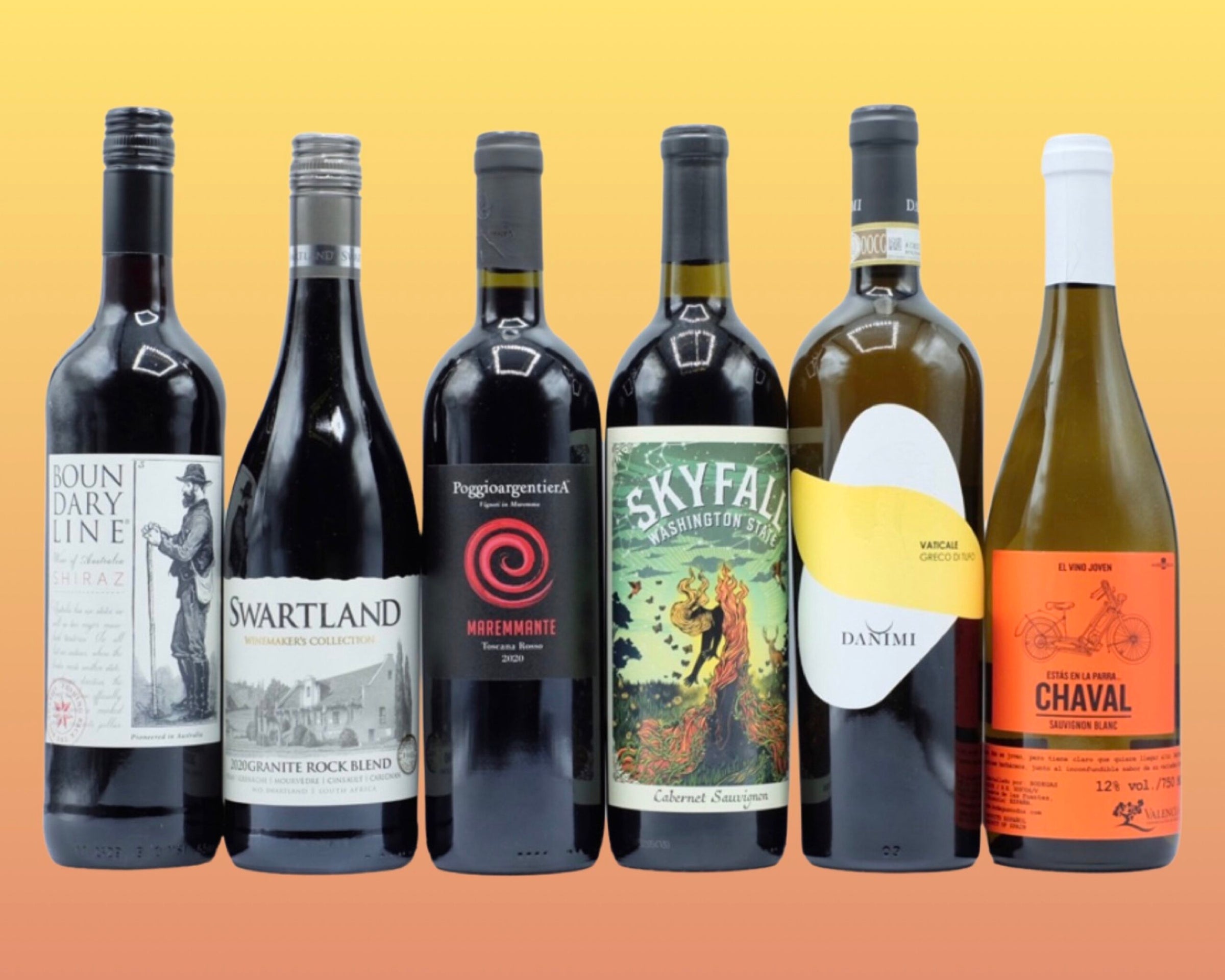| Welcome to the October edition of Vine Arts Wine Club! It's our pleasure to introduce these six new and delicious wines! We hope you enjoy them! For everyone signed up for pickup, your wines will be ready Saturday, October 1st at both locations. For everyone signed up for delivery, your wines will be delivered on Thursday, October 6th. Cheers! |
| 2019 Boundary Line Shiraz Riverina, Australia $20.84 | Where The wine region of Riverina is a sprawling tract of land located in New South Wales. A square shaped area roughly the size of Switzerland, this workhorse appellation is anchored by the city of Griffith. 20,000 hectares of vineyards are easily farmed thanks to the overall flat topography. The vineyards are entirely dependent on the Lachlan and Murrumbidgee rivers, the lifeblood of Riverina. Without their waters, viticulture in sundrenched Riverina would be near impossible. What Second only to Riverland in overall size, Riverina produces a significant amount of wine. Combined with nearby Murray Darling, the total equals three-quarters of all the wine made in New South Wales. Australia’s key wine brands are heavily invested. Without a doubt the most famous grape grown in Australia is Shiraz. It’s become ubiquitous with the rise of the country's wine industry. It’s thought to have been brought to Australia by the pioneer James Busby. French ‘Syrah’, while still bold, tends to be lighter and leaner. Australian ‘Shiraz’ tends to be richer and riper. These days winemakers can choose to label their wine with whichever name more aptly suits their style of wines. The grapes for this wine were sourced from vineyards scattered across Riverina. Harvested at optimal ripeness, the fruit was fermented with cultured yeasts in temperature controlled tanks. Who The Boundary Line Shiraz was created by Hallgarten and Novum Wines, one of the UK’s leading wine suppliers. Founded over 80 years ago, the business sources wines from around the world. The buying team is led by Steve Daniel, who is credited with introducing Greek and Chilean wine to the UK. Working with some of the finest family grape growers in the world, Daniel is able to create own brands for Hallgarten and Novum Wines. He collaborates with winemakers and existing wineries to produce wines that over-deliver in value. Taste Given the shift towards the lighter style of ‘Syrah’, it’s easy to forget just how pleasing good ‘Shiraz’ can be. Purple red in appearance, on the nose this wine has prototypical aromas of ripe blueberry, succulent plum, blackberry and clove. The palate is medium bodied with plush blackfruit flavors and velvety tannins. The finish is dry and fruity. Food pairing options abound, but you can’t go wrong serving this wine with barbecued beef or lamb. |
| 2020 Poggio Argentiera Maremmante Maremma, Italy $24.08 | Where The coastal region of Maremma is affectionately known as the ‘wild west’ of Tuscany. Home to some of the region's top wineries today, the area was effectively a swampy backwater less than 100 years ago. Bordering the Tyrrhenian Sea, Maremma was previously mostly malarial marshland unsuitable for viticulture. Its inhabitants, known as butteri, spent their days rustling cattle rather than grapes. It wasn’t until the 1930’s that suitable vine supporting soils were reclaimed when the swamps were drained. Compared with more inland areas, the overall climate is hotter during the summer but tempered by cool sea breezes. What It wasn’t until the 1980’s that the wines of Maremma became widely known; its rise owing to the success of the so-called ‘Super Tuscans’. Unlike the wines of traditional Tuscan appellations, these wines were heavily influenced by ideas from outside of Italy. French winemaking techniques and grape varieties were especially important. Initially sold as basic table wines, they literally changed how Italian wines were categorized. The Poggio Argentiera Maremmante is made from a blend of Cabernet Franc and Syrah harvested from vineyards in the Baccinello area. Located 350 meters above sea level, the mostly clay soil is rich in pebbles of alluvial origin. Fermented and macerated on the skins for two weeks, the wine was aged in stainless steel tanks. Who Poggio Argentiera was founded in 1997 with the purchase of the Adua farm. The property dates back to the early 20th century, when the Maremma marshlands began to be drained. Located within the Maremma DOCG of Morellino di Scansano, originally there were 6 hectares of vineyards. In 2001 this was built on with the acquisition of Keeling farm, which lies in the hilly section of Scansano. Altogether there are today 21 hectares of land under vine. The winery is managed by Giovanni Frascolla, the grandson of iconic Tuscan winemaker Rita Tua. Taste Made from French grapes, the Maremmante is a modern wine with a Mediterranean soul. Ruby red in appearance with purple inflections, the nose opens up with succulent aromas of wild blackberry, blueberry and black cherry. Not far behind you discover aromas of bacon fat and spice. The palate is medium bodied with round blackfruit flavors and smooth tannins. On the finish there’s a touch of warm herbaceousness. Meant to be consumed in its youth, we suggest serving this wine with Maremma style tortelli pasta covered in richly prepared ragù. |
| 2020 Swartland Granite Rock “Winemakers Collection” Red Blend Swartland, South Africa $24.00 | Where The large wine producing region of Swartland is located 65 kilometers north of Cape Town in the Western Cape of South Africa. Situated on the northern side of Paardeberg mountain, the landscape varies from steep mountain slopes, to gentle rolling hills. The name Swartland itself comes from the Dutch word for “black land”. The native renosterbos (rhinoceros bush) is widely found across the region, and turns black after the rains. Heavily planted to agriculture, Swartland is South Africa’s breadbasket. Planted mostly to grains, fruits, and vegetables, viticulture came recently to the region. Due to the harsh and dry climate, most vines are bush trained. Pushed hard to obtain moisture in the region's shale and granite soil, the vines produce small yields of concentrated fruit. This has led to the rise of intensely fruit forward wines. What The Swartland Granite Rock is made from a Rhône style blend of 60% Mourvèdre, 21% Syrah and 19% Carignan - grape varieties which are ideally suited to Swartlands sundrenched climate. After being harvested from mostly bush trained vines planted to granite rich soils, the grapes were transported to the winery where they were given an extended cold-soak prior to fermentation. During fermentation the wine underwent regular pumpovers (where the juice is drawn from the bottom of the tanks and pumped over the grape skins) and aeration. The wine was aged with a light touch of oak. Who Sitting 70 kilometers north of Cape Town, Swartland Winery has been producing wine for 70 years. At its inception, it was a cooperative wine cellar that brought together 15 grape growers. Somewhat unique for the time, the business was completely independent from the KWV, the major winemaking player during the apartheid era in South Africa. Expanding to 48 grape growers by the 1950’s, it became the first winery to promote the region of Swartland during the 1970’s. By the winery's 60th anniversary in 2008, the business represented 65 member growers. Although the Swartland Winery is today a privately owned entity, it still partners with grape growers who cultivate 3600 hectares of vineyards. Taste The Swartland Granite Rock “Winemakers Collection” Red Blend is a savory and meaty red wine with plenty of intensity for the price point. Deep ruby red in hue, on the nose there are punchy aromas of roasted black plum, mulberry, olive tapenade and tobacco. The palate is medium bodied with ripe blackfruit flavors and chocolatey tannins. The lingering finish is complemented by a kiss of oak spice. Serve this wine with boldly flavored meat based dishes and barbecued meats. |
| 2020 Skyfall Vineyard Cabernet Sauvignon Columbia Valley, United States $24.00 | Where Officially recognized with an AVA (American Viticultural Area) in 1984, the Columbia Valley is located in eastern Washington State. A small section of the appellation extends into neighboring Oregon. By no means small, the area has around 20,000 hectares planted to vine. Unlike western Washington state, the Columbia Valley enjoys a long and dry growing season with little moisture. This is due to the Cascade mountain range, which shields the vineyards from rainfall. Areas east of the Cascade mountain range enjoy double the amount of sunshine days than in soggy Seattle! The greatest threat to the vines are deep winter freezes that can plunge down to −18 °C. Grape growers try to mitigate this risk by installing large turbines that circulate air flow through the vines. Irrigation is near necessity in most vineyards. Within the Columbia Valley there are 9 smaller areas that have been given their own AVA’s. What Originally the Columbia Valley was best known for aromatic wines made from grapes like Riesling and Gewürztraminer. During the 1980’s this started to change when producers started to work with Bordeaux grape varieties. Today over 60% of the vineyard area is dedicated to red grape varieties. Wine critics such as Robert Parker have lavished praise on the region's bold and robust wines. A bottle of “cult” red wine from Columbia Valley can now be as expensive as top level Bordeaux or Napa Valley Cabernet Sauvignon. This red wine is made from 85% Cabernet Sauvignon, rounded out with 15% Syrah. In the winery the grapes were gently destemmed and crushed, prior to fermentation in temperature controlled tanks. The juice was pumped over the skins twice daily for ideal color and flavor extraction. The Cabernet component was aged 30% in 1st and 2nd year French oak barrels, and 70% in neutral oak barrels. The Syrah was aged 12 months in neutral oak barrels. Who Skyfall Vineyard was given its name from the massive boulders scattered amongst the vineyards, like meteorites fallen from the skies. In fact they are glacial boulders left in the wake of the ancient Missoula floods, which created the great Columbia river. The vineyards are overseen by 3rd generation grape grower Dave Minick, who takes a minimalist approach in farming. In the cellar, winemaker Nicole Walsh leads. With 23 vintages under her belt, Nicole spent nearly 20 years working with famed California winemaker Randall Graham. Taste Exuding classic Washington State character, the Skyfall Vineyard Cabernet Sauvignon is a robust and concentrated red wine. Deep ruby red in appearance, the nose boasts aromas of dusty black currant, cassis jam, dark chocolate and coffee bean. The palate is full bodied with creamy tannins and lush blackfruit flavors. Sweet spice complements the overall soft finish. A great everyday kind of wine, try it on its own or with a good old-fashioned cheese burger. |
| 2021 Danimi Vaticale Greco di Tufo Campania, Italy $29.08 | Where Campania Felix - the “Happy Land”. The shin of the italian boot, Campania was a prized part of Magna Græcia, an area of southern Italy settled by Greeks during the 8th century BC. To these new arrivals Italy was referred to as Enotria, “the Land of Wine”. The grape vine took well to the volcanic soil and mediterranean climate, and still does. Modern Italy’s third most densely populated region, it has 350 kilometers of coastline punctuated by the gulfs of Naples, Salerno and Policastro. The landscape is hilly and mountainous, with a small smattering of flatlands. As the thousands of tourists that flock to the Amalfi Coast can tell you, Campania bathes in the luxurious sunshine of long, dry, and hot summers. More inland winegrowing areas benefit from cooler continental influences. Aside from the likelihood that looming Mount Vesuvius will once again blow its top, Campania is near perfect for growing grapes. What In a land known for ancient grapes, Greco di Tufo is one of the oldest. The most prestigious white grape variety in Campania, it’s said to have been brought to Italy by the Pelasgians, a classical people from Thessaly in Greece (although this is debated). Genetically speaking it’s a particular clone of Greco Bianco, which is grown mainly in Lazio and Calabria. The ‘Tufo’ in the name comes from a village of the same name, and also the volcanic-ash soil type (known in English as ‘tuff’) to which the vineyards are planted. The Greco di Tufo DOCG appellation is reserved for wines from eight particular villages within the province of Avellino. The vineyards are planted between 450 and 500 meters, where cooler temperatures allow the grapes to retain their acidity. The Danimi Vaticale Greco di Tufo is made from grapes harvested from 15 to 20 year old vines located near the villages of Tufo and Montefusco. The wine was both fermented and aged in stainless steel tanks. Who The importance of family is heavily ingrained within the Danimi brand. The name derives from the names of owner Ciro Urciuolo’s three children - David, Nick, and Michela. For generations the Urciuolo’s have been connected to the land of Campania. Prior to selling their first vintage in 1996, the family grew chestnut trees in the foothills of Mount Faliesi. Today Danimi produces wines not only in Campania, but also in neighboring Puglia. Add to this, Ciro and his brother Antonello also produce wines under the Fratelli Urciuolo and Cantine Faliesi wine brands. Taste The Danimi Vaticale does a great job of capturing Greco di Tufo’s distinctive southern Italian character. Lemon-gold in appearance, the nose possesses floral aromas of peach, lemon peel and acacia. The medium bodied palate is fully dry with bitter stone-fruit and toasted almond flavors. A touch tannic with generous mouthfeel, there’s a lingering minerality on the finish. For food pairings think seafood. Whether grilled or fried, this wine can handle it. For a regional match, we suggest serving it with Neapolitan style Spaghetti con le Vongole. |
| 2021 Finca El Renegado Bodegas Nodus 'Chaval' Sauvignon Blanc Valencia, Spain $21.65 | Where Although better known for oranges, Valencia has been home to viticulture for thousands of years. Located in southeastern Spain, the appellation was awarded official status in 1957. Today there are around 13,000 hectares of vineyards spread across two distinct geographical areas, which are separated into 4 subzones. The subzone of Clariano is located south of the city of Valencia. The largest subzone, Valentino, lies above the coastal plains northwest of the city. The higher elevation vineyards of Alto Turia lie west of Valentino. Just outside of the city itself are the low-elevation vineyards of Moscatel. Ranging from mediterranean to semi-continental, the climate can be extremely hot. Some areas are classified as arid or semi-arid. What Sauvignon Blanc is not common in the region of Valencia. Far better known for the production of full-bodied red wines, the few Valencian white wines are more typically made from Macabeo and Merseguera. Moscatel de Alejandra is typically used for the product of decadent sweet wines. Chardonnay is the most popular international white grape variety. Sauvignon Blanc typically grows in cooler areas like France’s Loire Valley or New Zealand’s Marlborough wine region. In warmer regions such as Valencia, moderating factors are hugely important. In the case of the Bodegas Nodus 'Chaval' Sauvignon Blanc, the grapes were harvested from vineyards cooled by a surrounding pine forest and sea breezes. Who Finca El Renegado (“The Renegade”) is a 540 hectare estate located west of the city of Valencia in Utiel-Requena. Established in 1985 by Adolfo de las Heras Marín, about 80% of the vineyards today are planted to the indegenous Bobal grape variety. Planted to 200 hectares of vineyards, much of the estate is given to large swathes of pine and oak trees. When he started the winery, Adolfo was a pioneer in introducing Merlot and Cabernet Sauvignon into the area. Today the business is managed by his son Adolfo de las Heras Polo. The winery produces a range of wine brands, but the jewel in their crown are the Bodegas Nodus wines. Taste This Sauvignon Blanc has more ripeness than is typically expected from the grape variety. Pale straw yellow in appearance, the nose presents fragrant tropical aromas of lime, honeydew, and passionfruit. The light bodied palate is punctuated by tart acidity and fruity citrus flavors. The finish is crisp and refreshing. A great pairing for a bowl of gazpacho! |


